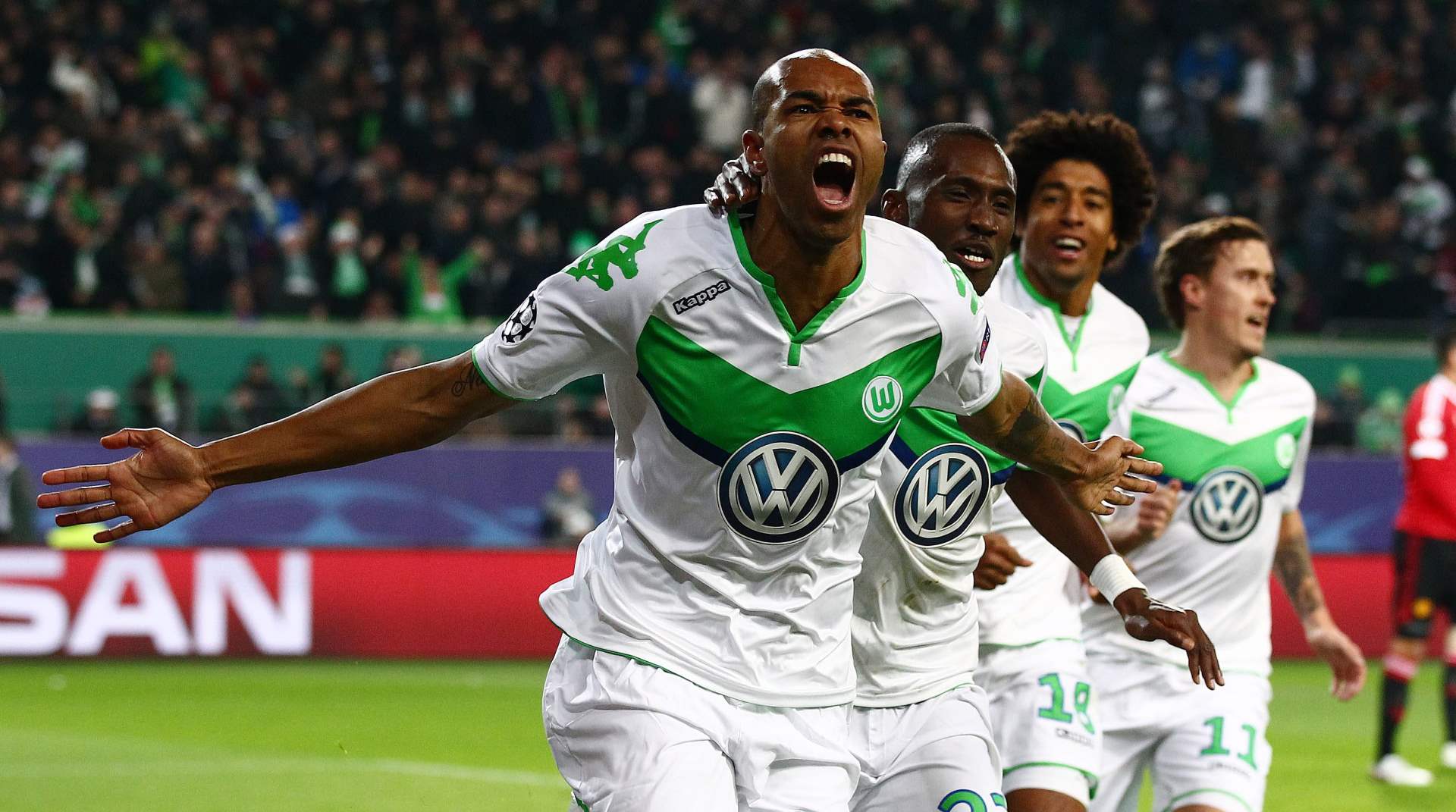 In my Bundesliga preview, I predicted Wolfsburg to score 15 fewer goals this season due to an unsustainably high conversion of deep completions to goals. This was when they still had Kevin de Bruyne. Right now they are basically on track with their performance prediction but also have lost De Bruyne. Successfully replacing an elite player without much drop-off in actual performance is a enormous win on its own (see Tottenham, Liverpool for how hard it is to do even when you get good value for the player) but there are other signs Wolfsburg is a club slowly going in the right direction. Some of these are obvious: winning a Champions League group is a huge milestone. Some are smaller game-to-game performance metrics that bode well for the future. The Basics
In my Bundesliga preview, I predicted Wolfsburg to score 15 fewer goals this season due to an unsustainably high conversion of deep completions to goals. This was when they still had Kevin de Bruyne. Right now they are basically on track with their performance prediction but also have lost De Bruyne. Successfully replacing an elite player without much drop-off in actual performance is a enormous win on its own (see Tottenham, Liverpool for how hard it is to do even when you get good value for the player) but there are other signs Wolfsburg is a club slowly going in the right direction. Some of these are obvious: winning a Champions League group is a huge milestone. Some are smaller game-to-game performance metrics that bode well for the future. The Basics 
![]() Here is what I am talking about when I say the performance is basically the same. Shots are slightly down (and from half a yard further out on average) but shots allowed are down further (and also from further out). Possession is up, and deep completions look pretty much exactly the same. If anything the balance of deep pass attempts has tipped in the direction of the Wolves. Besides the insane goal conversion rate which was coming down anyway unless Bas Dost kept shooting 40%, there's nothing you can point to and say "We really really miss Kevin". Their underlying performance both seasons indicates a team in the mix from 3rd-6th. The Offense
Here is what I am talking about when I say the performance is basically the same. Shots are slightly down (and from half a yard further out on average) but shots allowed are down further (and also from further out). Possession is up, and deep completions look pretty much exactly the same. If anything the balance of deep pass attempts has tipped in the direction of the Wolves. Besides the insane goal conversion rate which was coming down anyway unless Bas Dost kept shooting 40%, there's nothing you can point to and say "We really really miss Kevin". Their underlying performance both seasons indicates a team in the mix from 3rd-6th. The Offense 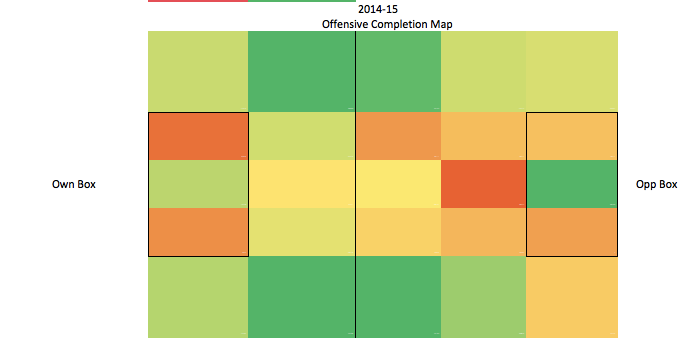
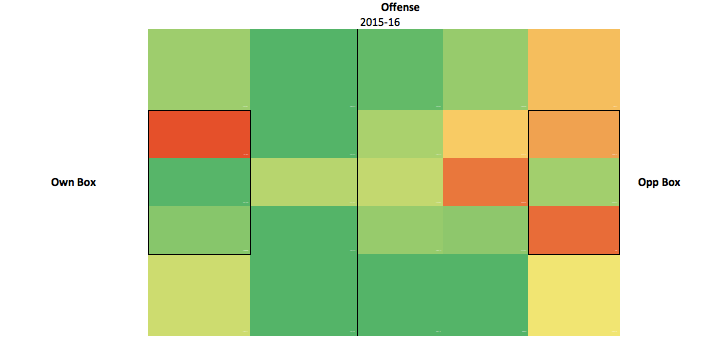 The brighter green a square is, the more completions a team has in that area of the pitch. This is Wolfsburg from last season on top and this season on the bottom. We can see that the Wolves are creeping further up the field this season, especially on that right wing. The center of the pitch is turning a little more green as well as the team as a whole seems to slowly be making the transition toward a self-sustaining attack instead of relying on lightning strike from De Bruyne. One of the driving factors has been Christian Träsch roaming forward from fullback. Only Bayern fullbacks complete more passes per game than Träsch. He advances the ball into attacking areas a lot better than Sebastian Jung did last season. Träsch has already played more minutes than he did last season and is 2nd on the team in completions in the attacking area (two vertical boxes furthest to the right above). Both Vierhinha (17.3) and Träsch (15.5) complete significantly more passes in the attacking area/90 than even De Bruyne (13.9) did last season when he led the team. The team as a whole completes 9 more passes per game in the attacking area. Last year Wolfsburg completed a higher proportion of their attacking passes on the wings than anyone else in the Bundesliga. I hypothesized that they would need to move the ball to the middle more this year with a player like Kruse (and Draxler who they signed after the preview) to create a more dangerous, less predictable attack. That hasn't happened, the wide proportion has actually gone up. In absolute terms they are in the middle of the pitch more and I think they do have a chance of a more central attack as the season goes on, which segues nicely into the next topic. The Replacements Draxler and Kruse Max Kruse from Gladbach and Julian Draxler from Schalke were the two attacking players brought in to help replace De Bruyne's production. This change is a big reason Wolfsburg have moved a little more towards a sustained possession style. De Bruyne was a heavy-action, forward moving attacking player while Draxler and Kruse can provide a key pass, but prefer to keep possession in the attacking area. Draxler and Kruse's completion% are both above 83%, elite territory for attacking players. De Bruyne was down at 74.5% last year, but the chart below showing where the players get and move to ball to explains that.
The brighter green a square is, the more completions a team has in that area of the pitch. This is Wolfsburg from last season on top and this season on the bottom. We can see that the Wolves are creeping further up the field this season, especially on that right wing. The center of the pitch is turning a little more green as well as the team as a whole seems to slowly be making the transition toward a self-sustaining attack instead of relying on lightning strike from De Bruyne. One of the driving factors has been Christian Träsch roaming forward from fullback. Only Bayern fullbacks complete more passes per game than Träsch. He advances the ball into attacking areas a lot better than Sebastian Jung did last season. Träsch has already played more minutes than he did last season and is 2nd on the team in completions in the attacking area (two vertical boxes furthest to the right above). Both Vierhinha (17.3) and Träsch (15.5) complete significantly more passes in the attacking area/90 than even De Bruyne (13.9) did last season when he led the team. The team as a whole completes 9 more passes per game in the attacking area. Last year Wolfsburg completed a higher proportion of their attacking passes on the wings than anyone else in the Bundesliga. I hypothesized that they would need to move the ball to the middle more this year with a player like Kruse (and Draxler who they signed after the preview) to create a more dangerous, less predictable attack. That hasn't happened, the wide proportion has actually gone up. In absolute terms they are in the middle of the pitch more and I think they do have a chance of a more central attack as the season goes on, which segues nicely into the next topic. The Replacements Draxler and Kruse Max Kruse from Gladbach and Julian Draxler from Schalke were the two attacking players brought in to help replace De Bruyne's production. This change is a big reason Wolfsburg have moved a little more towards a sustained possession style. De Bruyne was a heavy-action, forward moving attacking player while Draxler and Kruse can provide a key pass, but prefer to keep possession in the attacking area. Draxler and Kruse's completion% are both above 83%, elite territory for attacking players. De Bruyne was down at 74.5% last year, but the chart below showing where the players get and move to ball to explains that. 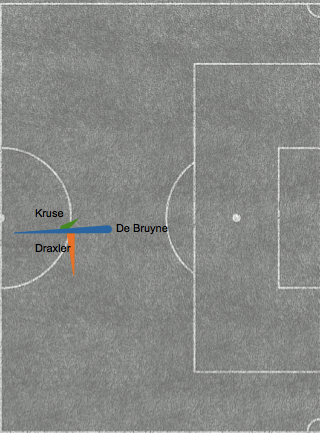 Kruse plays 32% of his passes forward, Draxler 41%. Last year De Bruyne played 50% of his passes forward. The reason I think they can move their attack a little more centrally is with Draxler healthy, they have two players who enjoy setting up shop there. The next chart shows the number of passes attempted per 90 in central areas between the halfway line and the box and how Draxler/Kruse are both more involved there than anyone from last season. The next step forward from team competing for Champions League spots to team who expects it will involve developing these two in the middle of the pitch to complement the wing blitzes from Träsch, Vierinha, and Schäfer, when he plays. Ricardo Rodriguez has the larger reputation but Schäfer has provided much more attacking this season when he plays at left back.
Kruse plays 32% of his passes forward, Draxler 41%. Last year De Bruyne played 50% of his passes forward. The reason I think they can move their attack a little more centrally is with Draxler healthy, they have two players who enjoy setting up shop there. The next chart shows the number of passes attempted per 90 in central areas between the halfway line and the box and how Draxler/Kruse are both more involved there than anyone from last season. The next step forward from team competing for Champions League spots to team who expects it will involve developing these two in the middle of the pitch to complement the wing blitzes from Träsch, Vierinha, and Schäfer, when he plays. Ricardo Rodriguez has the larger reputation but Schäfer has provided much more attacking this season when he plays at left back. 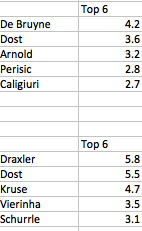 As for now, Kruse and Draxler are both providing 2.4 key passes per 90 to lead the team. It's taking two attacking spots but they add up exactly to De Bruyne's 4.8 from last season. The Defense
As for now, Kruse and Draxler are both providing 2.4 key passes per 90 to lead the team. It's taking two attacking spots but they add up exactly to De Bruyne's 4.8 from last season. The Defense 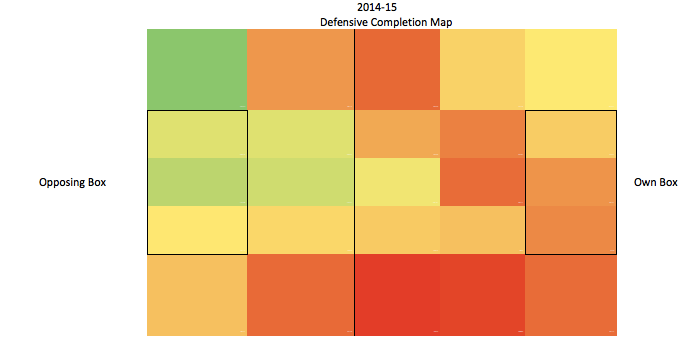
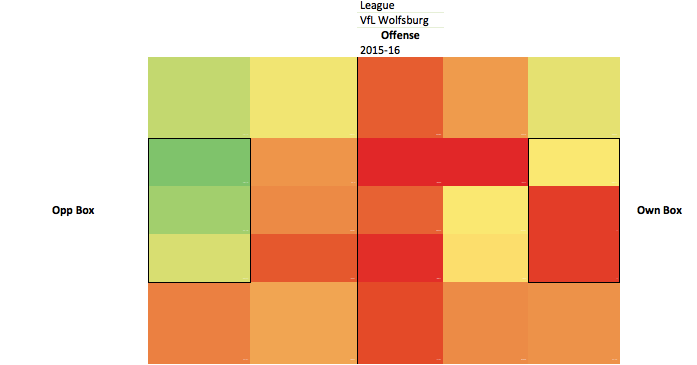 The increased red areas are not due to any sudden increase in defensive pressure, but facing fewer total passes because Wolfsburg have the ball more. The best defense is a good offense. Wolfsburg face fewer attacks because they have 57% possession, up from 54% last season. Opponents are actually completing a higher rate of their passes (75.3% up from 72.8%) but Wolfsburg's defense sees less of those passes. You can see the middle of the pitch is where teams go the least, Josuha Guilavogui might deserve some credit here. The midfielder intercepts nearly 5 passes per 90 which leads Bundesliga midfielders by a huge margin. The most notable stat about their defense is the lack of a high press but besides that it's just your typical solid defense like you see from Southampton, Gladbach or Roma.
The increased red areas are not due to any sudden increase in defensive pressure, but facing fewer total passes because Wolfsburg have the ball more. The best defense is a good offense. Wolfsburg face fewer attacks because they have 57% possession, up from 54% last season. Opponents are actually completing a higher rate of their passes (75.3% up from 72.8%) but Wolfsburg's defense sees less of those passes. You can see the middle of the pitch is where teams go the least, Josuha Guilavogui might deserve some credit here. The midfielder intercepts nearly 5 passes per 90 which leads Bundesliga midfielders by a huge margin. The most notable stat about their defense is the lack of a high press but besides that it's just your typical solid defense like you see from Southampton, Gladbach or Roma. Shot Map and Bas Dost Size of circle=shots/90, coloring=SOT%.
Shot Map and Bas Dost Size of circle=shots/90, coloring=SOT%. 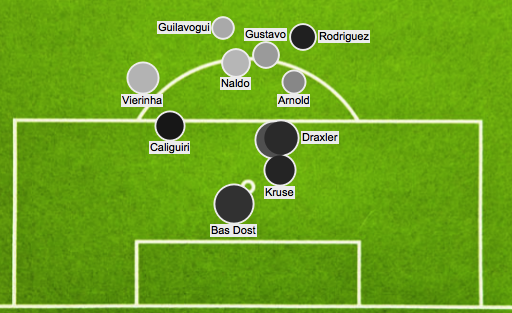 Bas Dost's average shot is coming from 11.8 yards out. That's very, very close, not quite as close as last years absurd 10.7 yards but still it's sub-penalty. He was an analytical piñata for his over-performance last season, but he has improved this year. Dost gets more involved in the build-up play, passes at a much better rate, and has picked up his shots/90 a bit. Wolfsburg can be satisfied with their solid start. They lost the player of the season and haven't seen any dip in performance levels. They've started to show signs of a more advanced sustained possession game and won a Champions League group for the first time in club history. They aren't leaping into Europe's elite, but are making the kind of progress that make it possible down the road.
Bas Dost's average shot is coming from 11.8 yards out. That's very, very close, not quite as close as last years absurd 10.7 yards but still it's sub-penalty. He was an analytical piñata for his over-performance last season, but he has improved this year. Dost gets more involved in the build-up play, passes at a much better rate, and has picked up his shots/90 a bit. Wolfsburg can be satisfied with their solid start. They lost the player of the season and haven't seen any dip in performance levels. They've started to show signs of a more advanced sustained possession game and won a Champions League group for the first time in club history. They aren't leaping into Europe's elite, but are making the kind of progress that make it possible down the road.
2015
The Post-De Bruyne World of Wolfsburg
By admin
|
December 10, 2015